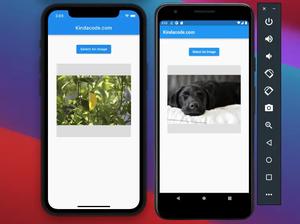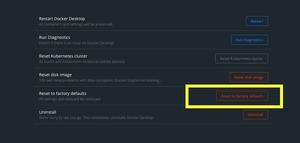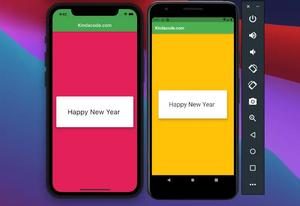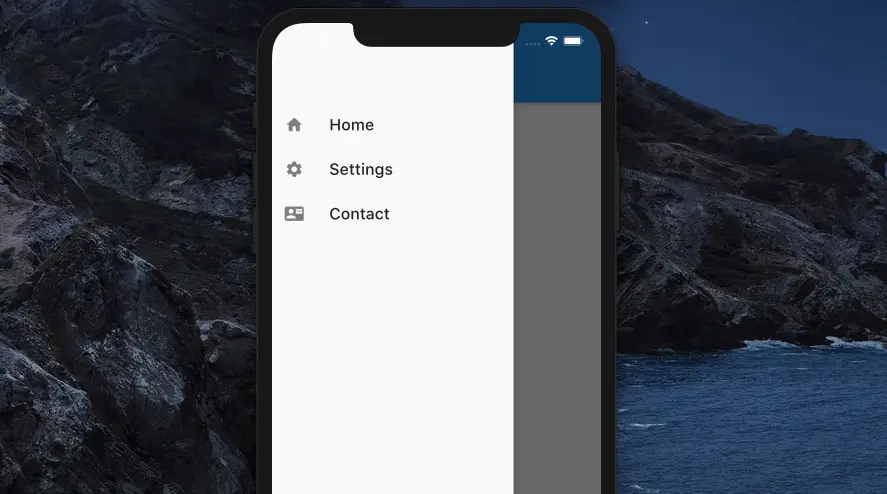
This article shows you how to implement a simple Drawer navigation menu in Flutter.
Table of Contents
Example Preview
We’ll build a small Flutter app that contains 3 screens (HomeScreen, SettingsScreen, and ContactScreen) and a Drawer Navigation. This Drawer has some tappable widgets for navigating. Here’s how our app works at the end:
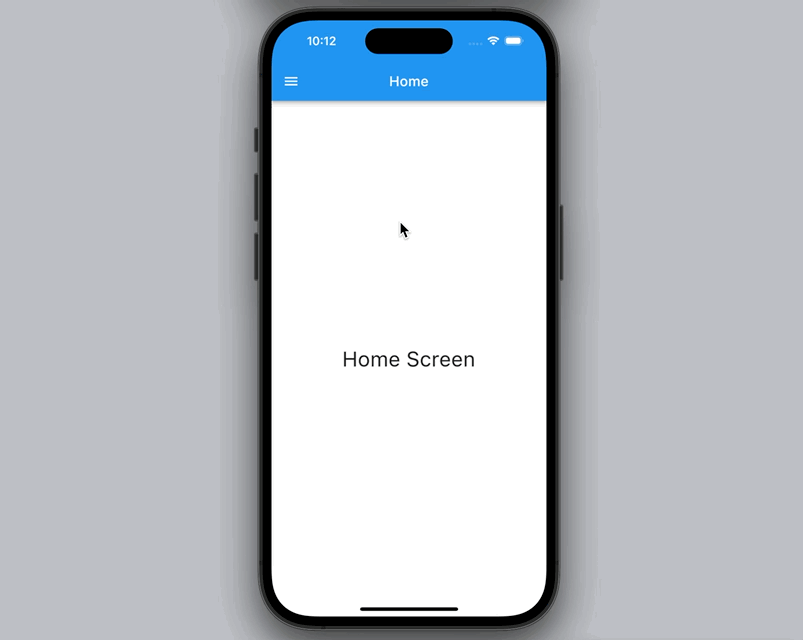
Here’s how to implement a drawer in general: tie the drawer property of a Scaffold widget and a Drawer widget together.
Widget build(BuildContext context) {
return Scaffold(
drawer: Drawer(
child: // the contents of the drawer
),
appBar: // app bar
body: // body code
);
}A Column or a ListView widget is usually used as the child of a Drawer widget to create a vertical list of menu items.
Note: The hamburger icon will automatically be added to the appBar after adding the drawer.
Let’s Write Code
1. Create a new Flutter project:
flutter create drawer_example2. Create 4 new files in the lib folder: home_screen.dart, settings_screen.dart, contact_screen.dart, and drawer.dart. Here’s the structure inside the lib folder:
.
├── contact_screen.dart
├── drawer.dart
├── home_screen.dart
├── main.dart
└── settings_screen.dart3. Add this code to the drawer.dart file:
// drawer.dart
import 'package:flutter/material.dart';
class MyDrawer extends StatelessWidget {
const MyDrawer({Key? key}) : super(key: key);
@override
Widget build(BuildContext context) {
return Drawer(
elevation: 6,
child: Column(children: [
const SizedBox(height: 100),
ListTile(
onTap: () {
Navigator.of(context).pushReplacementNamed('/');
},
leading: const Icon(Icons.home),
title: const Text(
'Home',
style: TextStyle(fontSize: 20),
),
),
ListTile(
onTap: () {
Navigator.of(context).pushReplacementNamed('/settings-screen');
},
leading: const Icon(Icons.settings),
title: const Text(
'Settings',
style: TextStyle(fontSize: 20),
),
),
ListTile(
onTap: () {
Navigator.of(context).pushReplacementNamed('/contact-screen');
},
leading: const Icon(Icons.contact_mail),
title: const Text(
'Contact',
style: TextStyle(fontSize: 20),
),
),
]),
);
}
}3. Add the following to home_screen.dart:
// home_screen.dart
import 'package:flutter/material.dart';
import './drawer.dart';
class HomeScreen extends StatelessWidget {
const HomeScreen({Key? key}) : super(key: key);
@override
Widget build(BuildContext context) {
return Scaffold(
drawer: const MyDrawer(),
appBar: AppBar(
title: const Text(
'Home',
),
),
body: const Center(
child: Text('Home Screen', style: TextStyle(fontSize: 30)),
),
);
}
}4. Add this to settings_screen.dart:
// settings_screen.dart
import 'package:flutter/material.dart';
import './drawer.dart';
class SettingsScreen extends StatelessWidget {
const SettingsScreen({Key? key}) : super(key: key);
@override
Widget build(BuildContext context) {
return Scaffold(
drawer: const MyDrawer(),
appBar: AppBar(
title: const Text('Settings'),
),
body: const Center(
child: Text('Settings Screen', style: TextStyle(fontSize: 30)),
),
);
}
}5. Add this to contact_screen.dart:
// contact_screen.dart
import 'package:flutter/material.dart';
import './drawer.dart';
class ContactScreen extends StatelessWidget {
const ContactScreen({Key? key}) : super(key: key);
@override
Widget build(BuildContext context) {
return Scaffold(
drawer: const MyDrawer(),
appBar: AppBar(
title: const Text('Contact'),
),
body: const Center(
child: Text('Contact Us', style: TextStyle(fontSize: 30)),
),
);
}
}6. Remove all the default code in main.dart and add this:
// // main.dart
import 'package:flutter/material.dart';
import './home_screen.dart';
import './settings_screen.dart';
import './contact_screen.dart';
void main() {
runApp(const MyApp());
}
class MyApp extends StatelessWidget {
const MyApp({Key? key}) : super(key: key);
@override
Widget build(BuildContext context) {
return MaterialApp(
// Hide the debug banner
debugShowCheckedModeBanner: false,
title: 'Kindacode.com',
home: const HomeScreen(),
// Register routes
routes: {
'/settings-screen': (BuildContext ctx) => const SettingsScreen(),
'/contact-screen': (BuildContext ctx) => const ContactScreen()
},
);
}
}8. Launch your iOS simulator, or Android emulator, then run:
flutter runFinal Words
We’ve examined a complete example of implementing a side drawer navigation menu. If you’d like to explore more new and fascinating stuff about Flutter and Dart, take a look at the following articles:
- How to Flatten a Nested List in Dart
- How to implement a right drawer in Flutter
- Flutter AnimatedList – Tutorial and Examples
- Using AnimatedIcon in Flutter
- 2 Ways to Add Multiple Floating Buttons in Flutter
- Flutter: Making a Dropdown Multiselect with Checkboxes
You can also check out our Flutter category page or Dart category page for the latest tutorials and examples.






